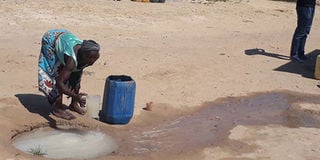Grim days await Kenyans as long rains fail

A resident in Kilifi County fetches water from a puddle following drought. PHOTO | FILE | NATION MEDIA GROUP
What you need to know:
- Met Department official blames rain failure to climate change.
- The acting deputy director of Kenya Meteorological Department, Mr Bernard Chanzu, said there is no immediate rainfall in the horizon.
The period has also persistently been plagued by high daytime and night-time temperatures of up to 41°C in some places.
It is official. There will be no rains this season, the weatherman has finally said, painting a grim picture of the long-awaited rainy season that is now drawing close to an end.
Acting Deputy Director of Kenya Meteorological Department Bernard Chanzu said Kenyans should not expect the March-April-May long rains.
He called on Kenyans to brace themselves for scarcity of water resources for drinking, sanitation and industrial use as well as for power generation.
DROUGHT
Mr Chanzu blamed the failed rains on climate change.
According to Mr Chanzu, there’s no immediate rainfall in the horizon this week and all the signs point to this state persisting to the end of the season.
“The bigger picture about prolonged dry spell which means a drought is foreseeable is growing increasingly clear,” he said on Tuesday, noting that their data shows that May would come and go without any rain.
The period has also persistently been plagued by high daytime and night-time temperatures of up to 41°C in some places.
Generally sunny and dry weather conditions have prevailed over most of the country during this season.
The Met said only several stations in the Western highlands such as Kisii, Nyamira, Bungoma, Trans-Nzoia, Kakamega, Busia, Homa Bay, and Kericho recorded substantial amounts of rainfall.
CYCLONE IDAI
Some parts of central highlands in Kiambu, Meru and Nairobi also experienced some irregular rainfall.
“This is because of the persistent high pressures over the Arabian region and the tropical cyclones in the western Indian Ocean,” the meteorologist said.
Cyclone Idai, which ripped through Mozambique last month, played a key role in delaying the northward movement of the rain-bearing inter-tropical convergence zone (ITCZ).
The ITCZ is a low pressure belt which shifts its position north and south of the equator according the position of the sun. It is here where rain-bearing trade winds converge.
The department also predicted the possibilities of more tropical convergences developing in the South-West Indian Ocean Basin that may delay further the onset over the eastern sector of the country.
“We’re experiencing a bad season. Historically, it is normal to experience variability of weather,” he said, adding “some years you get good weather, others you don’t. This is usually a possibility but the frequency with which these inconsistencies are happening is a hallmark of climate change.”
GLOBAL PHENOMENA
Initially the weather department had forecast that the long rains would begin in April, not in March as is the norm. They had also warned of generally depressed rains.
On Tuesday, however, Mr Chanzu said this sustained dryness is foreshadowing a future of parched rainless season with the bigger concern being that there will be no rains at all.
“It is something that is happening throughout the world and which is associated with the global atmosphere where precipitation patterns are being moved in new directions by climatic changes,” he said.
Ideally, the ‘long rains’ are an important rainfall season in Kenya, especially in western, Rift Valley and central regions which are the country’s breadbasket.
Many of Kenya’s farmers depend on rain-fed agriculture and the Met recommends planting crops that need very little rainwater.
“We’re not expecting good consistent rain and we’re warning farmers that they should improvise and seek alternative means of survival. The Agriculture ministry should advice Kenyans on what types of crops to plant with the information that we have provided,” he said.




